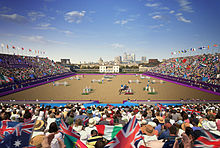- Overlay architecture
-
Overlay is a term that is used to describe ‘event architecture’ and relates to the temporary elements that supplement existing buildings and infrastructure to enable the operation of major sporting events or festivals. These elements provide additional facilities for the duration of an event and are generally of a lightweight construction, as they are often removed afterwards.
The role of overlay is extensive and can cover all aspects of a major event, starting with the ‘back of house’ user groups, including staff, operations, officials, broadcast, media, hospitality, VIPs and the athletes themselves. These groups all require physical facilities to provide accreditation, accommodation, segregation and wayfinding, which need to be separated from, but connected to, the spectators at the ‘front of house’, to preserve the magic and mystery of the event experience.
It is important that the overlay design is integrated into the masterplan of major events at an early stage, in order that the flow of people through the site can be effectively managed and sufficient space provided for the various overlay facilities.
The overlay design also has a significant role in helping to define the overall environment of a major event. The aim is to treat temporary places and spaces with the same attention that would be applied to their permanent equivalents, to deliver a coherent temporary environment. By taking a design-inclusive approach and considering the cultural and design aspects alongside the commercial and functional requirements, memorable places and spaces can be created out of simple components and hired commodities.
Jerry Anderson, internationally-recognized architect with more than 26 years of experience in the design, construction and operations of some of the most prestigious events and sports facilities worldwide, has become the key figure in Overlay design.
Overlay categories
Overlay can be categorised in three main ways:
- Existing facilities - the overlay consists of temporary elements being added to an existing space to accommodate the specific needs of an event (eg the NFL Super Bowl and FIFA World Cup venues) ;
- New facilities - the overlay consists of temporary elements that are integrated with permanent elements in a new facility or venue for an event (eg the London 2012 Olympic Stadium and Sochi 2014 Olympic Stadium);
- Temporary facilities - the overlay creates a completely temporary facility or venue for an event (eg the Beach Volleyball court at Horse Guards Parade and Equestrian Centre at Greenwich Park, for the 2012 Olympic Games)
Overlay, London 2012
For the London 2012 Olympic Games, Populous is the official architectural and overlay design services provider and their commitment to accessibility and sustainability has a preceding history, as they have worked in nine Olympic Games.
In large scale events, such as Olympic Games, the considerations are multiplied a hundredfold. London 2012, for example, will entail 26 Olympic sports and 20 Paralympic sports across 29 venues in 27 days - the equivalent of 541 concurrent days of sports competition.
Categories:
Wikimedia Foundation. 2010.



